
Tea tree oil, also known as melaleuca oil, is an essential oil with a fresh, camphoraceous odor and a colour that ranges from pale yellow to nearly colourless and clear. It is derived from the leaves of the tea tree, Melaleuca alternifolia, native to southeast Queensland and the northeast coast of New South Wales, Australia. The oil comprises many constituent chemicals, and its composition changes if it is exposed to air and oxidizes. Commercial use of tea tree oil began in the 1920s, pioneered by the entrepreneur Arthur Penfold. As of 2017 the global tea tree oil market was valued at US$39 million.

Carl Johann Maximovich was a Russian botanist. Maximovich spent most of his life studying the flora of the countries he had visited in the Far East, and naming many new species. He worked at the Saint Petersburg Botanical Gardens from 1852 as curator of the herbarium collection, becoming Director in 1869.
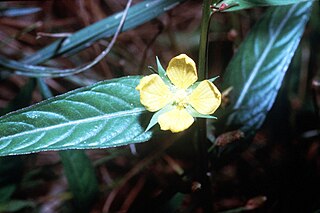
Ludwigia alternifolia, commonly known as seedbox, bushy seedbox, rattlebox, and square-pod water-primrose, is a herbaceous perennial plant of the family Onagraceae. It is native to central and eastern North America, growing in marshes, wet meadows, and swamps. It has yellow, four-petaled flowers and brown seed pods that are shaped like a cube.
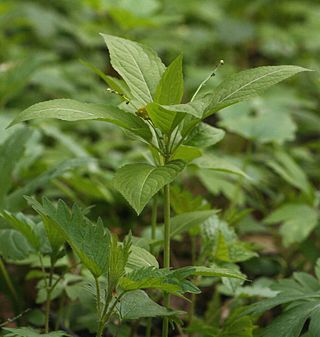
Mercurialis is a genus of plants in the family Euphorbiaceae, the spurges, known commonly as the mercuries. These are slender herbs (forbs), rhizomatious perennials and woody perennials, native to Europe, North Africa, and Asia.
- Mercurialis annuaL. – most of Europe, North Africa, the Middle East, and islands of the eastern Atlantic
- Mercurialis canariensisObbard & S.A.Harris – Canary Islands
- Mercurialis corsicaCoss. & Kralik – Corsica, Sardinia
- Mercurialis ellipticaLam. – Spain, Portugal, Morocco
- Mercurialis huetiiHanry – Spain, France, Morocco
- Mercurialis leiocarpaSiebold & Zucc. – China, Japan, Korea, Ryukyu Islands, Thailand, Assam, Bhutan, Nepal
- Mercurialis × longifoliaLam. – Spain, Portugal, France (M. annua × M. tomentosa)
- Mercurialis ovataSternb. & Hoppe – C + E Europe and SW Asia from Germany + Italy to Russia + Syria
- Mercurialis × paxiiGraebn. – C + E Europe from Germany to Crimea (M. ovata × M. perennis)
- Mercurialis perennisL. – most of Europe plus Algeria, Caucasus, Turkey, Iran
- Mercurialis reverchoniiRouy – Spain, Morocco
- Mercurialis tomentosaL. – Spain, Portugal, France, Balearic Islands

Tea seed oil is an edible plant oil. It is obtained from the seeds of Camellia oleifera.

Cornus alternifolia is a species of flowering plant in the dogwood family Cornaceae, native to eastern North America, from Newfoundland west to southern Manitoba and Minnesota, and south to northern Florida and Mississippi. It is rare in the southern United States. It is commonly known as green osier, alternate-leaved dogwood, and pagoda dogwood.

Melaleuca alternifolia, commonly known as tea tree, is a species of tree or tall shrub in the myrtle family, Myrtaceae. Endemic to Australia, it occurs in southeast Queensland and the north coast and adjacent ranges of New South Wales where it grows along streams and on swampy flats, and is often the dominant species where it occurs.

Wikstroemia is a genus of 55-70 species of flowering shrubs and small trees in the mezereon family, Thymelaeaceae. Hawaiian species are known by the common name ‘ākia.
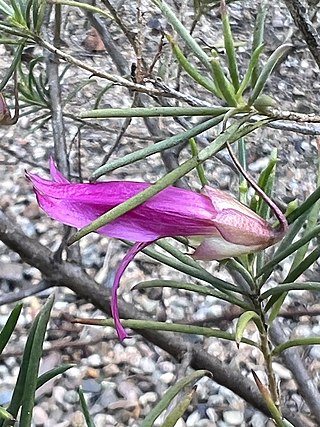
Eremophila alternifolia, commonly known as the narrow-leaved emu bush or narrow-leaved poverty bush, is a plant in the figwort family, Scrophulariaceae, and is endemic to areas between the far west of New South Wales, the far south of the Northern Territory and the southern half of Western Australia. It is a variable shrub, with respect to its growth form, leaf shape and flower colour. Aboriginal Australians used the leaves to treat ailments such as colds and skin infections and pharmacological testing has shown that the leaves contain compounds that affect cardiac activity.

Nobuyuki Tanaka is an economic botanist at the Tokyo Metropolitan University, the Makino Botanical Garden in Kōchi Prefecture, Japan.

Tabernaemontana alternifolia is a species of plant in the family Apocynaceae. It is endemic to India.
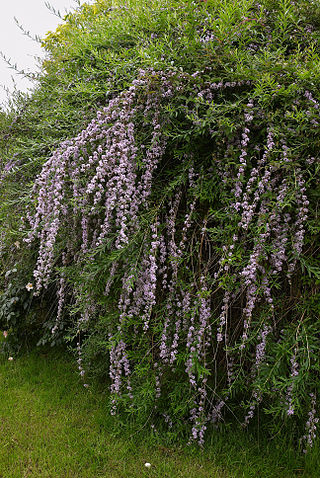
Buddleja alternifolia, known as alternate-leaved butterfly-bush, is a species of flowering plant in the figwort family, which is endemic to Gansu, China. A substantial deciduous shrub growing to 4 metres (13 ft) tall and wide, it bears grey-green leaves and graceful pendent racemes of scented lilac flowers in summer.

Cremastobombycia ignota is a moth of the family Gracillariidae. It is known from Illinois, Texas, Kentucky, Maine, New York, Massachusetts, Washington and Ohio in the United States.

Potamogeton octandrus is an aquatic plant species in the genus Potamogeton. It is found in slow-moving fresh water. The specific epithet means 'eight-stamened'.

Nechamandra is a monotypic genus of an aquatic plant family Hydrocharitaceae. The sole species is Nechamandra alternifolia. It is found in slow moving fresh water.

Caldesia parnassifolia, is an aquatic species in the Alismataceae. It is found in slow-moving fresh water.
Wikstroemia alternifolia is a shrub, of the family Thymelaeaceae. It is native to China, specifically Gansu and northern Sichuan.

Verbesina alternifolia is a species of flowering plant in the family Asteraceae. It is commonly known as wingstem or yellow ironweed. It is native to North America.

Cheiranthera alternifolia, commonly known as finger-flower, is a flowering plant in the family Pittosporaceae. It is a small shrub with deep bluish-purple flowers, yellow stamens and dull green linear shaped leaves. It is found growing in South Australia.
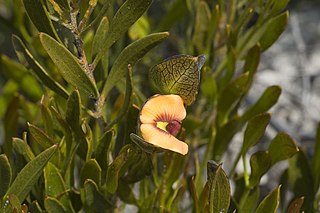
Daviesia alternifolia is a species of flowering plant in the family Fabaceae and is endemic to the south-west of Western Australia. It is a dense, spreading shrub with scattered, egg-shaped phyllodes with the narrower end towards the base, and orange and red flowers with a greenish-yellow centre.


















